In today’s competitive landscape, technology plays a crucial role in driving e-commerce expansion across North America. By utilizing advancements such as artificial intelligence and data analytics, businesses can streamline operations and enhance customer experiences, ultimately leading to scalable growth. This exploration of successful case studies reveals innovative strategies and measurable outcomes that can guide other companies in their technology-driven expansion efforts.
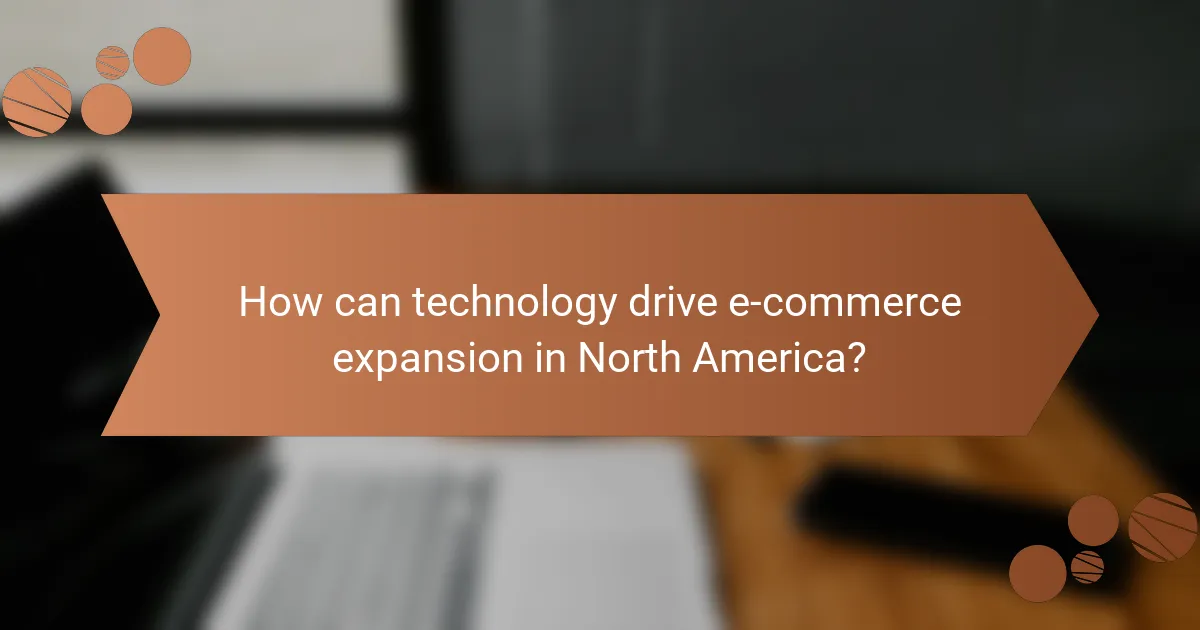
How can technology drive e-commerce expansion in North America?
Technology can significantly enhance e-commerce expansion in North America by streamlining operations, improving customer experiences, and enabling businesses to scale efficiently. By leveraging tools like artificial intelligence, data analytics, and cloud computing, companies can optimize their strategies and meet the evolving demands of consumers.
Utilizing AI for personalized shopping experiences
Artificial intelligence (AI) plays a crucial role in creating personalized shopping experiences that can drive customer loyalty and increase sales. By analyzing customer data, AI can recommend products tailored to individual preferences, improving conversion rates and enhancing user satisfaction.
For instance, e-commerce platforms can use AI algorithms to suggest items based on past purchases or browsing history. This targeted approach can lead to higher average order values and repeat business. Businesses should ensure they have robust data privacy measures in place to protect customer information while utilizing these technologies.
Implementing data analytics for inventory management
Data analytics is essential for effective inventory management, allowing e-commerce businesses to forecast demand accurately and reduce excess stock. By analyzing sales trends and customer behavior, companies can optimize their inventory levels, minimizing costs associated with overstocking or stockouts.
For example, retailers can use analytics tools to identify seasonal trends and adjust their inventory accordingly. This proactive approach can enhance operational efficiency and improve cash flow. Companies should regularly review their analytics strategies to adapt to changing market conditions and consumer preferences.
Leveraging cloud computing for scalability
Cloud computing offers e-commerce businesses the flexibility and scalability needed to grow in a competitive market. By utilizing cloud services, companies can easily adjust their resources based on demand, ensuring they can handle traffic spikes during peak shopping periods without significant upfront investments in infrastructure.
For instance, a retailer can scale their server capacity during holiday sales and scale back afterward, optimizing costs. Additionally, cloud solutions often provide enhanced security and backup options, which are critical for protecting sensitive customer data. Businesses should evaluate different cloud service providers to find the best fit for their specific needs and budget.

What are successful case studies of technology-driven expansion?
Successful case studies of technology-driven expansion demonstrate how companies leverage technology to enhance operations, improve customer experiences, and drive growth. These examples highlight innovative strategies and measurable outcomes that can inspire other businesses looking to expand through technology.
Amazon’s use of machine learning for customer recommendations
Amazon employs machine learning algorithms to analyze customer behavior and preferences, enabling personalized product recommendations. This technology not only enhances user experience but also significantly boosts sales, with estimates suggesting that up to 35% of Amazon’s revenue comes from these recommendations.
To implement a similar strategy, businesses should collect and analyze customer data, focusing on purchasing patterns and browsing history. Investing in machine learning tools can help create tailored experiences that resonate with individual customers, ultimately driving conversion rates.
Shopify’s integration of payment solutions
Shopify has successfully integrated various payment solutions, allowing merchants to offer multiple payment options to their customers. This flexibility improves the checkout experience, reducing cart abandonment rates and increasing overall sales.
Businesses looking to expand should consider integrating diverse payment methods, including digital wallets and buy-now-pay-later options. Ensuring a seamless payment process can significantly enhance customer satisfaction and loyalty, making it a crucial aspect of technology-driven expansion.
Walmart’s adoption of automated supply chain systems
Walmart has embraced automated supply chain systems to streamline operations and reduce costs. By utilizing advanced technologies such as robotics and real-time data analytics, Walmart can optimize inventory management and improve delivery efficiency.
Companies aiming for similar success should evaluate their supply chain processes and consider automation where feasible. Investing in technology that enhances visibility and responsiveness can lead to substantial cost savings and improved service levels, essential for competitive advantage in the retail sector.

What metrics indicate success in technology-driven expansion?
Success in technology-driven expansion can be measured through various metrics that reflect growth, efficiency, and customer engagement. Key indicators include customer retention rates, conversion rates from personalized marketing, and operational efficiency metrics.
Increased customer retention rates
Higher customer retention rates signify that a business is successfully engaging its existing customers, which is crucial for sustainable growth. Companies often aim for retention rates above 70%, as retaining customers is typically less expensive than acquiring new ones.
To enhance retention, businesses can leverage technology for personalized communication and tailored experiences. Regularly analyzing customer feedback and behavior can help identify areas for improvement, ensuring that customers feel valued and understood.
Higher conversion rates from personalized marketing
Personalized marketing strategies can significantly boost conversion rates, often achieving increases of 20-30% or more. By utilizing data analytics, businesses can create targeted campaigns that resonate with specific customer segments, leading to higher engagement and sales.
To implement effective personalized marketing, companies should invest in customer relationship management (CRM) tools that allow for detailed segmentation and tracking of customer interactions. A/B testing different approaches can also help refine messaging and offers for maximum impact.
Improved operational efficiency metrics
Operational efficiency metrics gauge how well a company utilizes its resources to produce goods or services. Improvements in this area can lead to cost savings and enhanced productivity, with many businesses aiming for efficiency gains of 10-20% through technology adoption.
Key steps to improve operational efficiency include automating repetitive tasks, optimizing supply chain processes, and utilizing data analytics for informed decision-making. Regularly reviewing performance metrics can help identify bottlenecks and areas for further enhancement.
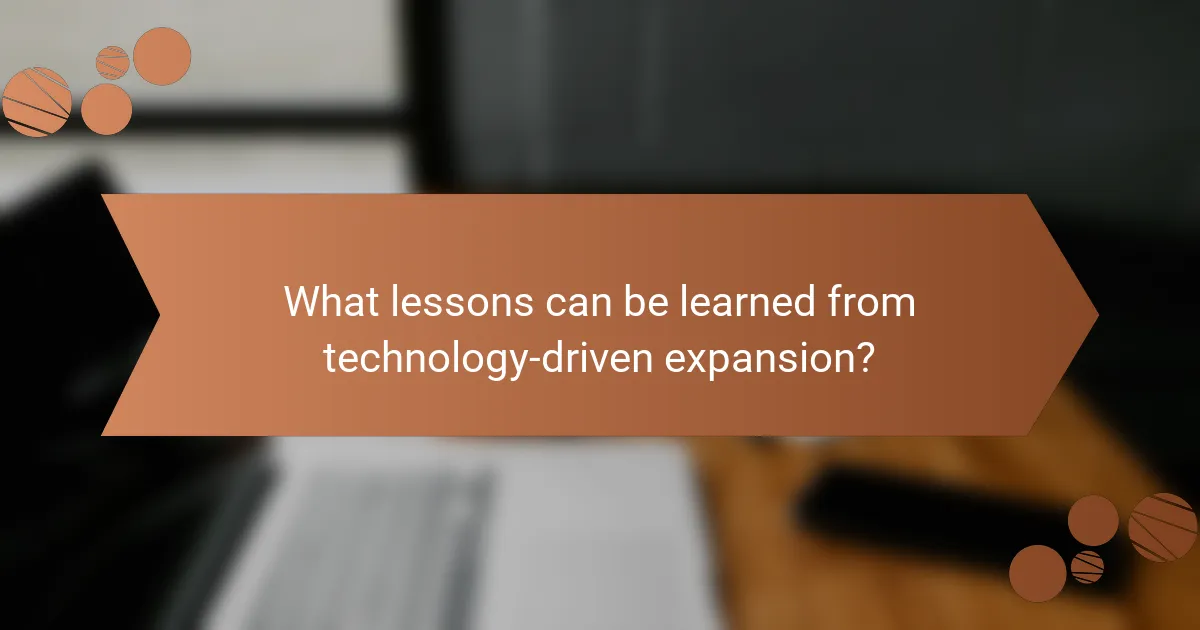
What lessons can be learned from technology-driven expansion?
Technology-driven expansion teaches businesses the importance of aligning their strategies with customer needs and market dynamics. Key lessons include leveraging customer feedback for effective tech implementation and the necessity of adapting to ever-changing market trends.
Importance of customer feedback in tech implementation
Customer feedback is crucial for successful technology implementation as it provides insights into user preferences and pain points. Engaging with customers through surveys, focus groups, or direct interactions can help identify features that enhance user experience and drive adoption.
For example, a software company may discover through feedback that users prefer a simplified interface, prompting them to prioritize user-friendly design in their updates. Regularly collecting and analyzing feedback can lead to continuous improvement and increased customer satisfaction.
Need for continuous adaptation to market trends
Continuous adaptation to market trends is essential for maintaining competitiveness in a technology-driven landscape. Businesses must monitor industry developments, emerging technologies, and shifting consumer behaviors to stay relevant and responsive.
For instance, a retail company might need to integrate e-commerce solutions as online shopping becomes more prevalent. Establishing a flexible strategy that allows for quick pivots can help organizations capitalize on new opportunities and mitigate risks associated with market changes.
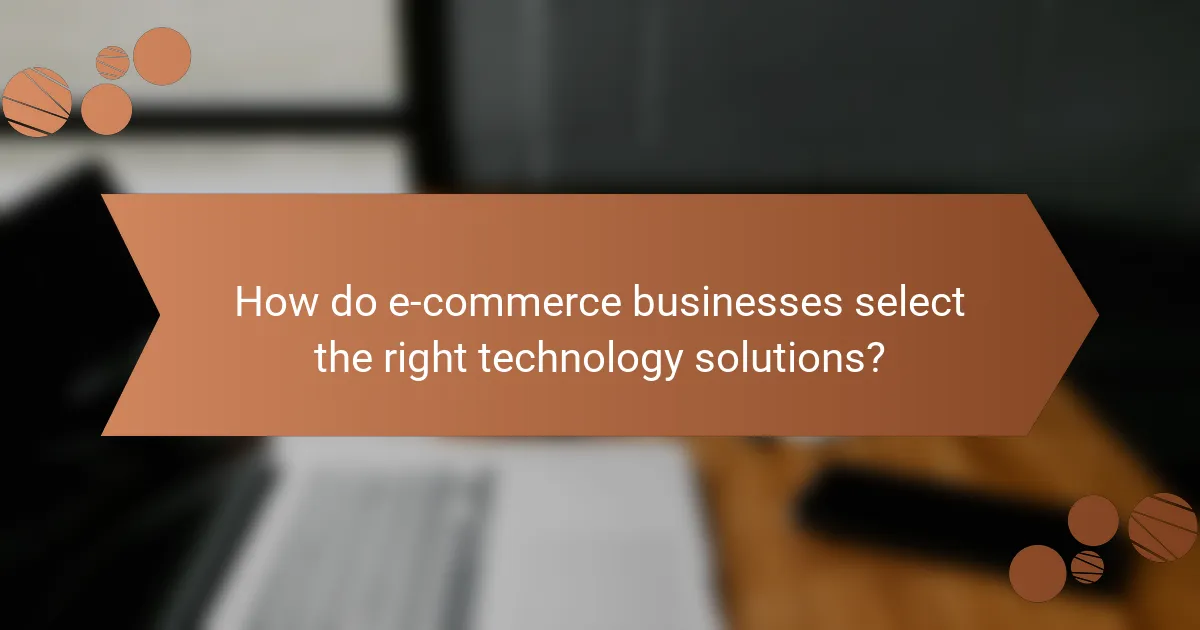
How do e-commerce businesses select the right technology solutions?
E-commerce businesses select technology solutions by evaluating their specific needs and aligning them with available options. Key factors include compatibility with existing systems, potential return on investment (ROI), and scalability for future growth.
Evaluating compatibility with existing systems
Compatibility with existing systems is crucial for seamless integration and operational efficiency. Businesses should assess whether new technology can easily connect with current platforms, such as inventory management or customer relationship systems.
To evaluate compatibility, consider conducting a technology audit. Identify current systems and their capabilities, then compare these with the features of potential new solutions. Look for solutions that offer APIs or integration tools to facilitate smooth connections.
Assessing ROI for technology investments
Assessing ROI for technology investments involves calculating the expected benefits against the costs incurred. This includes direct financial returns, such as increased sales, as well as indirect benefits like improved customer satisfaction and operational efficiency.
To effectively assess ROI, businesses can use a simple formula: ROI = (Net Profit from Investment / Cost of Investment) x 100. It’s advisable to consider both short-term gains and long-term impacts, ensuring that the technology aligns with strategic goals. Common pitfalls include underestimating implementation costs and overlooking training expenses.
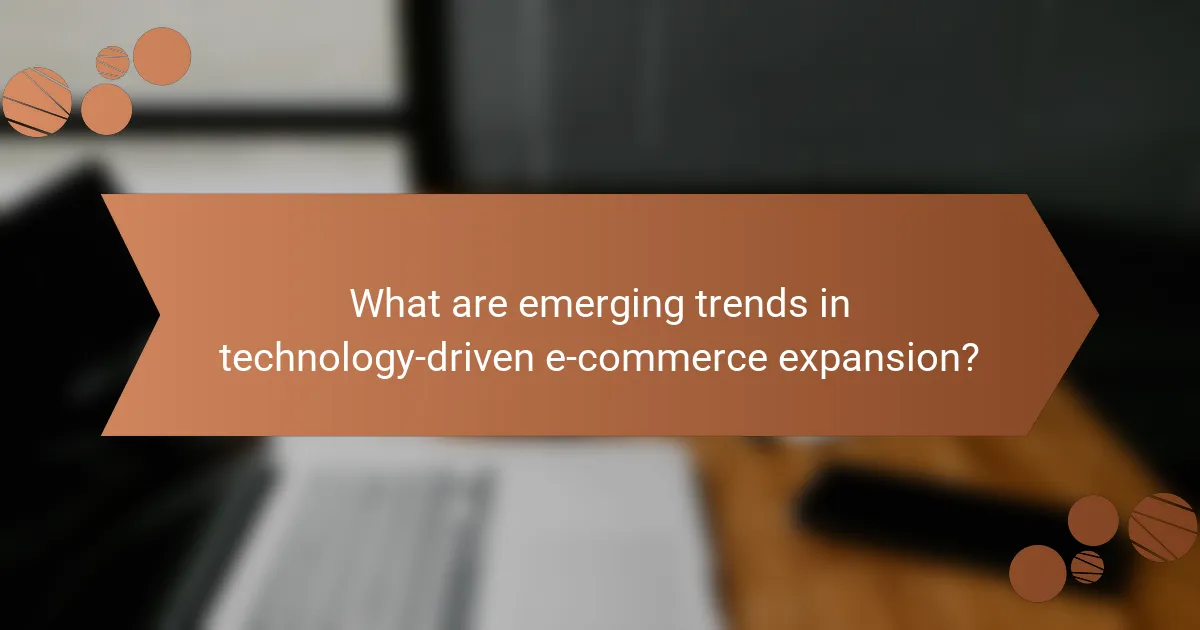
What are emerging trends in technology-driven e-commerce expansion?
Emerging trends in technology-driven e-commerce expansion include the integration of augmented reality and blockchain technology, which enhance customer experience and transaction security. These innovations are reshaping how businesses engage with consumers and manage their operations.
Rise of augmented reality in online shopping
Augmented reality (AR) is transforming online shopping by allowing customers to visualize products in their own environment before making a purchase. This technology can significantly reduce return rates and increase customer satisfaction by providing a more interactive shopping experience.
Retailers can implement AR through mobile apps or web platforms, enabling users to see how furniture fits in their living room or how clothing looks on them. Companies like IKEA and Sephora have successfully adopted AR, showcasing its effectiveness in boosting sales and enhancing user engagement.
Growth of blockchain for secure transactions
Blockchain technology is gaining traction in e-commerce for its ability to provide secure, transparent transactions. By decentralizing data storage, blockchain minimizes the risk of fraud and enhances trust between buyers and sellers.
Businesses can leverage blockchain for various applications, such as verifying product authenticity and streamlining supply chain processes. Companies like Walmart and De Beers are exploring blockchain to improve traceability and accountability in their operations, which can lead to increased consumer confidence and loyalty.
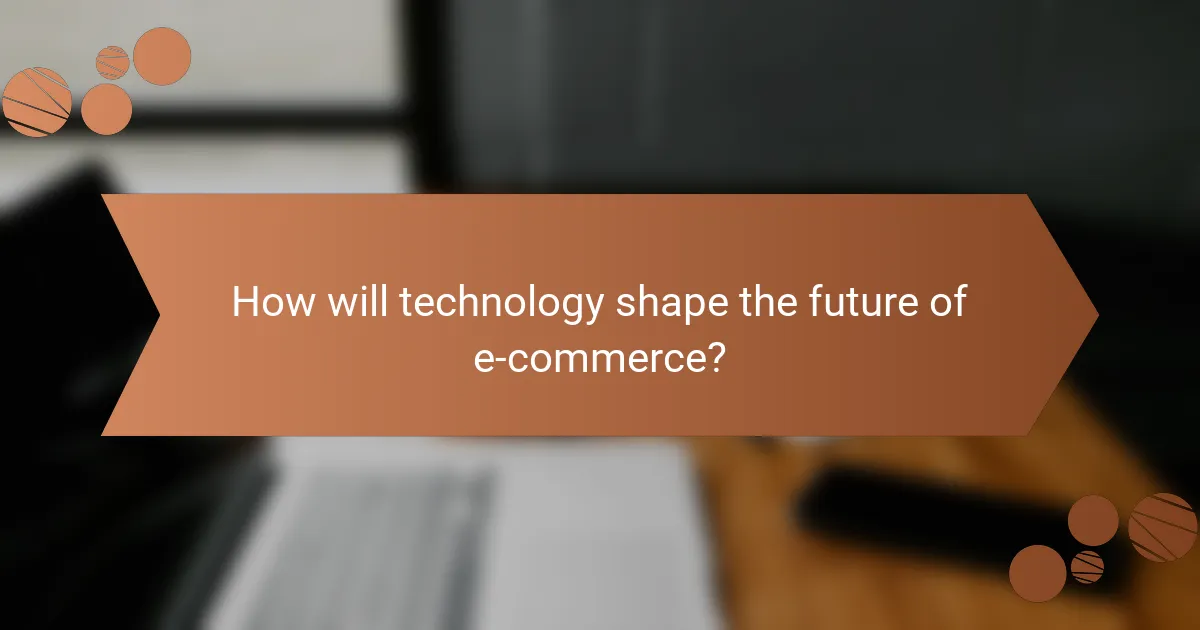
How will technology shape the future of e-commerce?
Technology is set to significantly transform e-commerce by enhancing customer experiences, streamlining operations, and enabling personalized marketing. Innovations such as artificial intelligence, augmented reality, and blockchain are driving these changes, making online shopping more efficient and engaging.
Case Studies of Technology-Driven E-Commerce Success
Several companies have successfully leveraged technology to boost their e-commerce platforms. For instance, Amazon uses advanced algorithms to recommend products based on customer behavior, leading to increased sales. Similarly, Warby Parker employs augmented reality to allow customers to virtually try on glasses, enhancing user engagement and reducing return rates.
These case studies illustrate how integrating technology can lead to improved customer satisfaction and higher conversion rates. Businesses that adopt similar strategies often see significant growth in their online sales.
Success Metrics for Technology Integration
Measuring the success of technology in e-commerce involves various metrics, including conversion rates, average order value, and customer retention rates. Companies should track these metrics before and after implementing new technologies to assess their impact.
For example, a retailer that introduces a chatbot for customer service may monitor response times and customer satisfaction scores to evaluate effectiveness. A successful integration typically results in improved metrics across the board, indicating a positive return on investment.
Lessons Learned from Technology Implementation
One key lesson from technology implementation in e-commerce is the importance of user experience. Technologies should enhance, not complicate, the shopping process. Companies must ensure that new tools are intuitive and seamlessly integrated into their existing systems.
Additionally, businesses should remain adaptable and open to feedback. Regularly assessing customer responses to new technologies can provide valuable insights for further improvements. Avoiding over-reliance on technology without understanding customer needs is crucial for sustained success.


